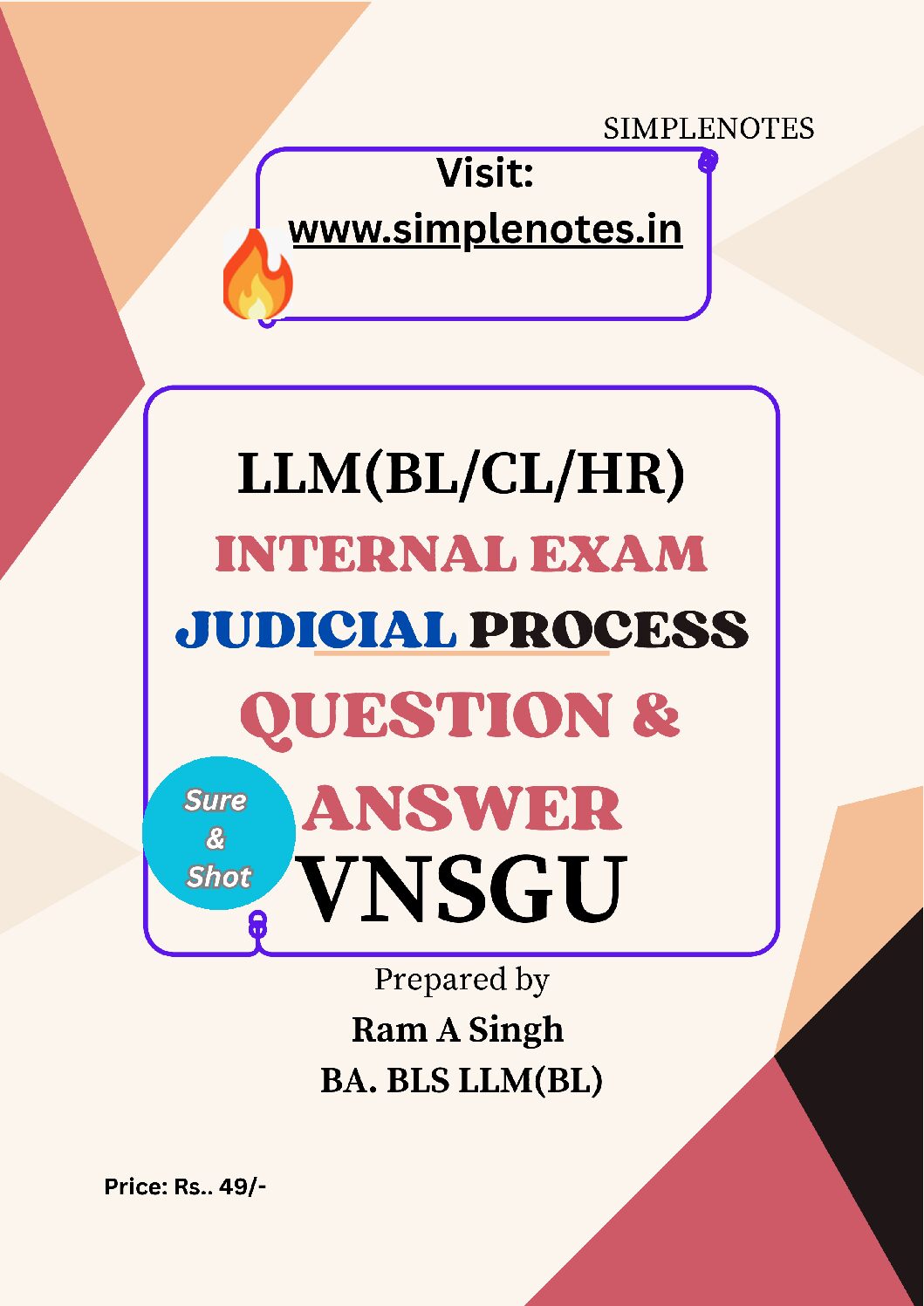Judicial process: The judicial process is the foundation of every legal system in a democracy. It is the process through which judges make decisions in court cases. It is how laws are applied to real-life problems and how justice is delivered to people.
Many believe that the judicial process is just about courtrooms, lawyers, and written laws. But it is much more than that. It is a thoughtful and balanced process. It includes logic, fairness, ethics, and the understanding of society’s needs. For law students, understanding the judicial process is essential. It helps them see how law actually works in practice.
Synopsis
Why the Judicial Process Matters
The judicial process ensures that people can approach courts when their rights are violated. It provides a peaceful and legal way to settle disputes. It checks the power of governments and protects individuals.
Without a fair judicial process, there would be no rule of law. The strong would dominate the weak, and injustice would spread. That is why the judicial process is considered a key pillar of democracy and justice.
Read this too: In 8 points Know why Intellectual Property Rights Matter in the Indian Economy
What Does the Judicial Process Mean?
The word “judicial” is related to judges and courts. The word “process” refers to the steps taken to reach a result. So, the judicial process means the method used by courts to settle legal problems and give judgments.
It includes many things: listening to both parties, studying the facts, reading the law, applying earlier judgments, and finally writing a decision. The famous judge, Benjamin Cardozo, once said that the judicial process is how judges decide what the law is and how it should be used.
A Key Part of the Judicial Process

Laws are often written in general terms. They do not always cover every situation. When such gaps appear, judges interpret the law.
Take Article 21 of the Indian Constitution, for example. It says that no one shall be deprived of life or liberty except according to law. At first, it was interpreted in a narrow way. But over time, the Supreme Court said that the right to life includes the right to live with dignity, the right to privacy, the right to a clean environment, and more. This shows how interpretation plays a huge role in making the law relevant to modern times.
The Creative and Evolving Nature of the Judicial Process
The judicial process is not a fixed or mechanical activity. Judges sometimes create new legal rules when no law exists or when the law is unclear. This shows the creative and evolving nature of the process.
For instance, in the Kesavananda Bharati case, the Supreme Court introduced the Basic Structure Doctrine. It said that parliament cannot change some parts of the Constitution, even with a majority. This idea was not written in the Constitution, but it became one of the most important legal principles in India.
Read this too :How to Register a GI in India in 8 steps: Step-by-Step Guide
In the Vishaka case, the court issued guidelines to stop sexual harassment at the workplace. At that time, no law existed. The court filled the gap using constitutional values and international human rights norms.
Role of Judicial Reasoning: Law with Logic in Judicial Process
Judges do not decide cases based on personal views. They must give reasons for their judgments. These reasons are based on logic and legal rules. This is known as judicial reasoning.
A well-written judgment explains the facts, the law used, and the logic behind the decision. This helps future courts follow the same path. It also helps people understand why a decision was made. This transparency builds public trust in the judicial system.
The Role of Precedents in the Judicial Process
In countries like India, courts follow earlier decisions made in similar cases. This is known as the Doctrine of Precedent. It brings consistency and stability to the legal system.
For example, if the Supreme Court decides a case one way, lower courts must follow that decision when similar cases come up. This helps lawyers and judges predict the likely result of cases and promotes fairness.
Well-Reasoned and Value-Based Decision-Making
The judicial process is not just about law and logic. It also includes ethics and social values. Judges are guided by the principle of justice. They care about what is right and fair, not just what is legal.
For example, in many judgments related to human rights, the courts have shown compassion. In the Navtej Johar case, the Supreme Court decriminalized homosexuality. This was based on constitutional values of equality, dignity, and freedom. The judicial process, therefore, must balance written law with human values
Read this too: Geographical Indication vs Appellation of Origin: What’s the Difference?
Balancing Rights and Interests
Many cases involve a clash between two important rights. For example, one person’s freedom of speech may hurt another person’s right to reputation. Judges must balance these rights.
This is where the judicial process becomes delicate. The judge must listen to both sides, understand the issue, and then decide what is more important in that situation. This is not easy, but it is necessary.
How the Judicial Process Works Step by Step
The judicial process follows a sequence of steps:
- A person files a case in court.
- The court issues a notice to the other party.
- Both parties get a chance to present facts and legal arguments.
- The judge listens carefully, reads the law, studies past judgments, and then gives a written decision.
This decision may be accepted or challenged through appeal. Appeals can go from the district court to the High Court and finally to the Supreme Court. At each level, the judicial process ensures that the decision is fair and just.
Judge’s Role in the Judicial Process
- A Judge plays the most important role in the entire process. He is responsible for ensuring fair hearings, interpreting laws correctly, and delivering justice without bias.
- A judge must be independent, neutral, and well-informed. Their decision must be based on law, facts, and reason—not personal beliefs or political pressure.
- Judges are also guardians of the Constitution. In India, they have the power to strike down laws that violate fundamental rights. They can also guide the government to follow the law properly.
Rule of Law and Judicial Process
The rule of law is the idea that everyone is equal under the law. No one is above the law, not even the government.
The judicial process is the mechanism that ensures this rule of law. Through this process, courts check whether laws are followed, whether the government is acting within its powers, and whether people’s rights are protected.
Without a strong and fair judicial process, the rule of law would remain only a theory. It is the judicial process that brings it to life.
Judicial Process Around the World: Common Law vs Civil Law
In India and other common law countries like the UK and USA, the judiciary plays a very active role. Judges create laws through their judgments. These case laws become part of the legal system.
In civil law countries like France and Germany, the legislature writes detailed laws, and judges mainly apply those laws. They have less power to interpret or create new laws.
So, the nature of the judicial process varies, but its aim—delivering justice—remains the same.
Problems with the Judicial Process
Although the judicial process is essential, it is not perfect. One major problem is delay. Cases in Indian courts often take years, sometimes even decades, to reach a final judgment. This causes great hardship to those waiting for justice.
Another issue is cost. Legal procedures are expensive. Poor people often cannot afford to hire good lawyers. Court fees, travel, and document preparation also cost money.
Courts are also overloaded with cases. Judges have to handle hundreds of matters every month. This affects the quality and speed of justice.
There is also criticism of judicial overreach. Sometimes, courts interfere in areas that are better handled by the government or parliament. This creates conflict between the branches of government.
Social Justice and Judicial Process
Despite its flaws, the judicial process has played a big role in bringing social justice to India.
The courts have expanded the meaning of rights. They have protected the poor, the marginalized, and the voiceless. Through public interest litigation, courts have taken up cases for environmental protection, workers’ rights, children’s welfare, and many more.
In the Shayara Bano case, the court declared the practice of instant triple talaq as unconstitutional. In the Unnikrishnan case, the court recognized the right to education. In all these cases, the judicial process responded to social needs, not just legal texts.
Well-Known Judgments That Show the Nature of the Judicial Process
Several landmark judgments in India show how powerful and flexible the judicial process is.
- In the Kesavananda Bharati case, the court protected the Constitution from being changed completely by Parliament.
- In the Maneka Gandhi case, the court expanded the right to life and personal liberty.
- In the Vishaka case, the court filled the gap in law by creating guidelines to prevent sexual harassment.
- In the Navtej Singh Johar case, the court upheld the rights of the LGBTQ community.
- In the Shayara Bano case, the court gave relief to Muslim women against the practice of triple talaq.
These judgments show that the judicial process is alive and constantly evolving.
Conclusion: The Soul of the Legal System
The judicial process is much more than a legal procedure. It is the living soul of the legal system. It reflects our values, protects our rights, and ensures justice.
It involves careful reasoning, human compassion, and moral responsibility. It balances legal rules with real-life needs. It keeps the law flexible yet firm.
For law students, understanding the judicial process is the key to understanding law itself. It teaches how justice is delivered, how judges think, and how society is shaped by legal decisions.
In every society, justice is not just expected—it is essential. And it is the judicial process that ensures that justice is not just a dream, but a reality.
Bibliography
- Basu, D. D. (2023). Introduction to the Constitution of India (26th ed.). LexisNexis.
- Cardozo, B. N. (1921). The nature of the judicial process. Yale University Press.
- Jain, M. P. (2023). Indian constitutional law (8th ed.). LexisNexis.
- Joshi, K. C. (2021). The Constitution of India: Text and commentary. Eastern Book Company.
- Ministry of Law and Justice. (2024). The Constitution of India (Bare Act with short notes). Government of India.
Retrieved from https://legislative.gov.in - Perry, R. W. (2019). Understanding judicial reasoning. Stanford University Press.
- Supreme Court of India. (n.d.). Landmark judgments. Retrieved June 25, 2025, from https://main.sci.gov.in
- Legal Services India. (n.d.). Judicial process and legal interpretation in India. Retrieved June 25, 2025, from https://www.legalservicesindia.com
- Bar and Bench. (n.d.). News and analysis on Indian judiciary. Retrieved June 25, 2025, from https://www.barandbench.com
- LiveLaw. (n.d.). Supreme Court judgments and legal updates. Retrieved June 25, 2025, from https://www.livelaw.in
![]()









